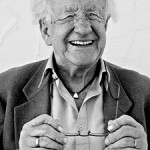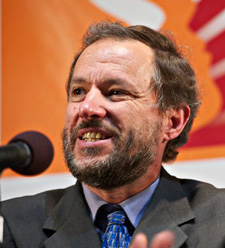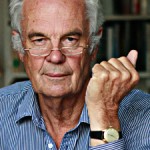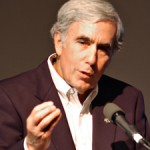Archive for the ‘Disarmament’ Category
TFF nominated for the Nobel Peace Prize
TFF PressInfo, September 12, 2013
Summary
The Transnational Foundation for Peace and Future Research (TFF), founded on September 12, 1985 – today 28 years ago – is nominated for the Nobel Peace Prize 2013 and so are three TFF Associates:
• Richard Falk, professor in international law at Santa Barbara and Princeton, the UN S-G’s envoy for the Occupied Territories;
• David Krieger, founder (1982) and president of The Nuclear Age Foundation devoted to nuclear abolition;
• Jan Oberg, co-founder and director of TFF.
Background
World renown expert on the Nobel Peace Prize, Norwegian lawyer Fredrik Heffermehl*, says:
– Nobel dedicated his prize to “the “champions of peace” (not to “peace” in general). Not that many of those we know from open sources are nominated this year are qualified, but a select few are eligible, like the American Professor Richard Falk, Norwegian Ambassador Gunnar Garbo, American David Krieger of the Nuclear Age Peace Foundation, the former Director General of UNESCO Federico Mayor, Spain, Swedish peace scientist and organizer Jan Oberg, as well as American Professor of peace education Betty Reardon.
– These clearly are the kind of “champions of peace” described in Nobel’s will, working for global disarmament based on global law. Read the rest of this entry »
The US has no credibility dealing with chemical weapons
By Stephen Zunes
This is an updated and expanded version of the article “The US and Chemical Weapons: No Leg to Stand On,” originally posted in Foreign Policy in Focus on May 2, 2013.
Had the United States pursued a policy stemming the proliferation of chemical and other nonconventional weapons through region-wide disarmament, when it was proposed in 2003 by Syria, it is likely there would be no apparent use of such ordnance and no present rush to war on that basis, says Zunes.
The Syrian regime’s alleged use of chemical weapons against civilian areas on August 21 constitutes a breach of the Geneva Protocol of 1925, one of the world’s most important disarmament treaties, which banned the use of chemical weapons.
In 1993, the international community came together to ratify the Chemical Weapons Convention (CWC), a binding international treaty that would also prohibit the development, production, acquisition, stockpiling, retention, and transfer or use of chemical weapons. Syria is one of only eight of the world’s 193 countries not party to the convention.
However, US policy regarding chemical weapons has been so inconsistent and politicized that the United States is in no position to take leadership in any military response to any use of such weaponry by Syria. Continue reading at TruthOut
Alternative defence for states – transarmament
By Johan Galtung
 Speech held in the Senate, Rome, July 23, 2013
Speech held in the Senate, Rome, July 23, 2013
Your Excellencies, Foreign Affairs, Defense, EU…
SYSTEMS: A Reorientation
[1] Transarmament: States use armies for defense, and for offense, for wars. Si vis pacem, para bellum, peace through security tries to cover both; but offensive military threatens, provokes arms races, even wars. Si vis pacem para pacem, security through peace is not disarmament leaving regions, states and local level defense-less; rather, it identifies conflicts and traumas underlying violence in order to solve them, builds peaceful state relations, and defensive defense “just in case”.
[2] Nonalignment: Solidarity and help to victims of aggression should be based on the merits of the case, not by alliance membership. This implies NATO and EU transarmament to regional defensive defense, and UN world collective defense under representative military command.
[3] Being useful to other countries: having developed positive relations such that others want to enhance, not destroy the country. There are many ways: through mutually beneficial trade, tourism for nature or culture, through support when suffering attacks, or social and natural catastrophes, by serving as experts in peace-building.
[4] Being less vulnerable: political-military decentralization so that aggression against any sector-part does not paralyze the whole country; resistance, and much normal life, can be continued.
Economic self-reliance, especially energy/food–self-sufficiency only as a possibility in emergencies–not to be tempted into attacking others if trade fails, keeping economic sectors–primary, secondary, tertiary, quaternary for reproduction–intact; producing for basic needs at home as much as possible, getting the rest through trade.
Defense against spying by not having secrets; transarmament works openly, to prevent and deter. A more cooperative, less competitive economy (more cooperatives, less companies); inviting others to join.
ALTERNATIVE: Building Peace
[5] Conflict resolution. Read the rest of this entry »
Russia’s power is not weapons, it’s culture
By Jonathan Power
Observers say that what drives President Vladimir Putin is to make Russia respected. But perhaps Putin overestimates how much power Russia already has. He has overlooked which trumpets to blow – it is not his “hang tough” policies in international affairs, especially vis-a-vis the United States. It is Russia’s culture.
These thoughts were prompted by watching the opening of the new, quite beautiful, extension of the Mariinsky theatre in St Petersburg on Mezzo television, the French cable station for classical music. (You can see it on U-Tube.)
The Mariinsky is run by Valery Gergiev and he arranged a show (and conducted it) so rich and of such supreme achievement that it overshadowed in my memory all the great performances I’ve seen, whether in London, New York, Paris or Moscow. Each segment lasted a bare 4 minutes and it alternated between opera, ballet and two solo violinists and one pianist. It went on for two hours or more with the greatest stars of the Russian firmament, plus two or three Western performers.
Putin was in the audience, not in the official box but down in the middle of the stalls. Was he aware of the political power of an event like this? I doubt it. Nor of the power of the rest of Russia’s great inheritance. Read the rest of this entry »
An octogonal world
By Johan Galtung
Let us try a look at the world from above, right now. There is so much drama unfolding. Is there a Big Picture? Of course there is, we all have one, so here is one effort, imgaine it as The Octagon, consisting of these eight big states or regions:
1) USA, 2) Russia, 3) India, 4) China, 5) OIC (the Organization of Islamic Conference, the 57 Muslim countries), 6) EU (27), 7) Africa (AU, African Union, 54 countries) and 8 ) CELAC, Latin America and the Caribbean, 33 countries). We might add Israel and Japan to the USA if the criterion is willingness to go to war with and for the USA – but Israel wants the USA to fight its wars, and Japan, even with Japanese hawks more than willing to join the nuclear club, is still bound by the constitution depriving Japan of the right to war. So they work for a new constitution with an emergency article that could justify a military take-over. Ominous. Hopefully Germany does not follow suit. Read the rest of this entry »
USA-East Asia looking in the abyss
By Johan Galtung
From Kyoto, Japan
It has never been this bad since the 1950-53 Korea war.
October 1962, the Cuba-USSR-USA crisis, comes to mind. There were horror visions of mushroom clouds. A proud Cuba, with a strong leader-dictatorship, a social revolution in the near past, was denied a normal place in the state system, bullied by the USA and some allies with sanctions and boycotts into isolation for now more than 50 years.
Soviet Union shipped nuclear-tipped missiles for deployment as close to USA as the US missiles deployed in Turkey to Soviet Union. And in that was the solution, tit for tat, one nuclear threat for the other, in negotiations kept secret, ultimately revealed by McNamara.
Three countries were involved in 1962; in the current crisis five countries, a pentagon and not two but three nuclear powers:
North Korea < - > China
South Korea < - > Japan < U.S. >
– with the USA-Japan and USA-South Korea alliances pitted against the tacit China-North Korea alliance.
With the unreconciled traumas, of Japan having colonized Korea 1910-45, attacking China and USA during the Pacific War 1931-45; USA using nuclear bombs against Japan 1945; occupying Japan and South Korea; North Korea attacking South Korea; UN-USA counter-attacking, including China (MacArthur), ending in 1953 with an armistice; then 60 years of immensely frustrating quest for unification with the annual USA-South Korea+ Team Spirit exercises close to North Korea.
And, more recently, the USA-China competition for the No. 1 economic world position, the US effort to build economic alliances with the EU and with the Pacific in Trans-Pacific Partnership, and then the Japan-China conflict over the Daiyou-Senkaku islands. To top it: North Korea’s threatening with nuclear weapons, fascist like anybody threatening to turn others into ashes, but so far only verbal violence.
Nonetheless, even against a background like that, there are some ways of defusing this Three against Two pentagon. Read the rest of this entry »
The UN Arms Trade Treaty is not perfect
By Jonathan Power
US presidential candidate Jimmy Carter described arms sales as a “cancer”. But once in office Carter achieved little in controlling them.
In President Bill Clinton’s first term Amnesty International questioned the US government about the use of American military helicopters and armoured vehicles involved in human rights abuses in Turkey. Under pressure from Congress the State Department compiled a report on human rights violations by the Turkish armed forces. It concluded there was “highly credible” evidence that US-supplied arms and jet fighters had been used to subdue Kurdish villages.
Later, in 1996, the US temporarily suspended the sale of advanced attack helicopters. But two years later there were fresh reports that hundreds more armoured vehicles had been sold. The US Defence Secretary visited Turkey and reportedly lobbied on behalf of American companies wishing to co-produce advanced helicopters there. In that same year an American company sold 10,000 electric shock weapons to the Turkish police.
Read the rest of this entry »
Envisioning a world without nuclear weapons
By Richard Falk
Book Review
ZERO: THE CASE FOR NUCLEAR WEAPONS ABOLITION
By David Krieger (published in 2013 by the Nuclear Age Peace Foundation); $14.95
I have known David Krieger for the past twenty-five years, and he has never wavered, even for a day, from his lifelong journey dedicated to ridding the world of nuclear weapons and the threat of nuclear war. If I were given to categorization, I would label such an extraordinary engagement with a cause as an instance of ‘benign fanaticism.’
Unfortunately, from the perspective of the human future, it is a rather rare condition, posing the puzzle as to why Krieger should be so intensely inclined, given his seemingly untraumatized background. He traces his own obsession back to his mother’s principled refusal to install a bomb shelter in the backyard of their Los Angeles home when he was 12 years old. He comments in the Preface to ZERO that even at the time he “hadn’t expected” her to take such a stand, which he experienced as “a powerful lesson in compassion,” was especially moved by her unwillingness “to buy into saving herself at the expense of humanity.” (xiv).
Nine years later after Krieger graduated from college his mother was again an instrumental force, giving him as a graduation present a trip to Japan to witness first-hand “what two nuclear weapons had done to the cities of Hiroshima and Nagasaki.” (xiv) The rest is, as they say, ‘history.’ Or as Krieger puts it in characteristic understatement, “[t]hose visits changed my life.” (xiv) Read the rest of this entry »
The US cliff, swamp, quagmire: Two major proposals
By Johan Galtung
There is more than the fiscal cliff to meet the naked eye.
Wise people – Borosage, Krugman, Stiglitz – some of them economists, see neither the fiscal deficit nor the US debt but the lack of growth as the key problem. They point to Clinton years and how, through growth, the Debt/GDP ratio went from a half to a third. This is important, but then there is a fourth consideration: some Americans are suffering out there. “16 percent” comes up very often, of people and families below the poverty line, not knowing for sure where the food comes from the next day, not having medical insurance. Macroeconomics is blind to human basic needs, yet there may even be solutions hidden in it.
But after the Clinton years came somebody else; increasing expenditure with enormously costly wars making conflicts even worse, and in addition lowering the revenue by reducing taxes on the super-rich. That a fiscal deficit would rear its ugly head, fed by such policies year after year, was a foretold conclusion. Democracy protects the president with a golden parachute, similar to that enjoyed by the CEO of a bankrupt company. But rightly so: he was elected, even re-elected. US voters, you asked for it and you got it! Read the rest of this entry »
Reflections on the Cuban Missile Crisis at fifty
By David Krieger
Fifty years ago this month, the world teetered on the precipice of a nuclear war between the US and Soviet Union during the 13-day Cuban Missile Crisis. We were fortunate to have survived that crisis, thanks largely to the restraint shown by President Kennedy and Premier Khrushchev.
Now, fifty years later, there is no immediate crisis such as that in 1962 over Soviet nuclear-armed missiles being placed in Cuba. There are, however, still some 19,000 nuclear weapons in the arsenals of nine nuclear-armed nations: the US, Russia, UK, France, China, Israel, India, Pakistan and North Korea. Approximately 95 percent of these weapons are in the arsenals of the US and Russia. Some 2,000 of them are kept in a state of high alert, ready to be immediately launched upon an order to do so at any moment of any day or night. Read the rest of this entry »




